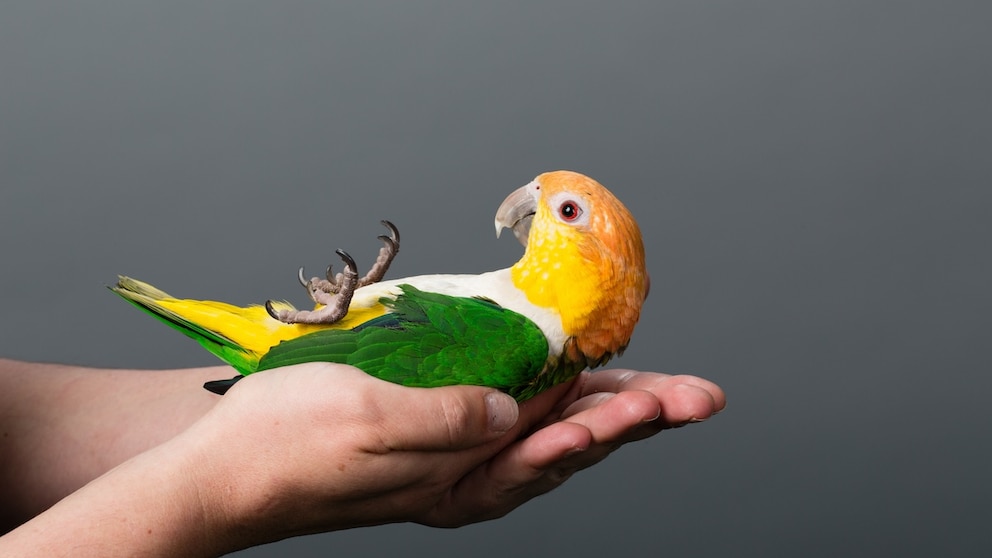November 7, 2024, 3:09 pm | Read time: 5 minutes
Claw trimming is an important and regular maintenance measure for owners of ornamental birds such as budgies or parrots. However, there are a few points to bear in mind. Dr. Ursula von Einem from the Bundesverband Praktizierender Tierärzte e. V. explains how to do it properly.
Just as people regularly trim their fingernails and toenails, it is also important for pet birds to have their claws trimmed regularly. While humans can do this themselves, budgies, parrots, and the like are dependent on our help. PETBOOK asked an expert how and how often you should trim your bird’s nails.
What is important when trimming bird claws
“As birds are very susceptible to stress, it is important to proceed as quickly and calmly as possible when catching and holding the bird,” explains Dr. Ursula von Einem from the German Association of Practicing Veterinarians (Bundesverband Praktizierender Tierärzte e. V.) when asked by PETBOOK. As pet birds and parrots often cannot see well in the dark, a darkened room is ideal for catching them.
The right techniques and tools for trimming bird claws
“You can trim claws using specialized claw scissors or nail clippers,” explains Dr. von Einem. In addition to the right tools, the right technique also plays an important role when trimming claws.
You should cut from the side and at an angle so that the cut edge runs in the same direction as the previous claw edge (direction of abrasion). The reason is that if the claws are cut against the direction of abrasion, the birds may not find a secure hold on the perches afterward.
Using a cloth or gloves for safety
To prevent the bird from recognizing and biting the hand, the expert suggests concealing it with a cloth or glove. It is, therefore, advisable for two people to work together when cutting claws. “One person holds and restrains the bird. The second person cuts the claws,” advises Dr. von Einem. Especially with large birds such as parrots, it is advisable to wrap them in a towel, according to Dr. von Einem. However, in order not to overstrain the animals, this procedure should be practiced with them beforehand.
Nevertheless, cutting is stressful for the animals. According to the expert, one thing is therefore essential: “Calmness when catching and holding and working quickly are important. The faster it goes, the less stress the animal has. Nevertheless, work must be carried out carefully so that the animal is not injured and does not suffer any pain.” She adds: “If cutting the claws doesn’t work at all, the vet will be happy to help.”
Important: Do not injure nerves and blood vessels
As with humans, birds’ claws should not be cut too short, as this can lead to pain and injury. Excessively short claws can damage the nerves and blood vessels that run through the middle of the claws, which is not only painful for the animal but can also lead to bleeding. But how do you recognize them?
“With light-colored claws, you can usually see the nerves and blood vessels clearly,” says Dr. von Einem. With dark claws, on the other hand, it is more difficult to spot them. The expert says: “With dark claws, it is often difficult to see ‘the life,’ i.e., the nerves and blood vessels. It can work here if you place a strong light source behind it that shines through the claw.”
Soap can help with claw injuries
The expert recommends maintaining a “safety margin” of at least two to approximately eight millimeters from the claw’s base when trimming to prevent injuring the bird. “The nerves and blood vessels, which are located roughly in the middle of the claw, must not be injured,” the expert points out.
If the claw does start to bleed after the cut because a blood vessel has been injured, Dr. von Einem from the veterinary association has a tip: “A piece of soap can be effective – by gently rubbing it over the cut, you can quickly and easily seal the open wound. If it bleeds more heavily and for a long time, please visit a veterinary practice on the same day.”

Paw care How to correctly cut a rabbit’s claws

Paw care Should you cut your cat’s claws?

According to the "Guinness Book of Records" This Is the Most “Bloodthirsty” Bird in the World
How often should you clip your bird’s claws?
In the wild, birds naturally wear down their claws. How often the claws of birds kept as pets need to be trimmed depends on various factors, for example:
- The type of bird: different bird species grow their claws at different rates.
- The texture of the perches: Perches with hard or rough surfaces contribute to natural claw wear.
- The activity of the bird: More active birds use their claws more, which can lead to faster abrasion.
It is, therefore, not possible to give a general answer to the question of how often the claws should be trimmed. In general, however, you can extend the intervals or even avoid clipping claws altogether – by encouraging claw abrasion. According to Dr. von Einem, this is easy to do.
“Different thicknesses and materials of perches are a start. Natural – i.e., unsprayed and non-toxic – wood with the most varied and rough surfaces possible is highly recommended. Placing a rough stone near the water dish and feeding areas can also promote claw wear.”

